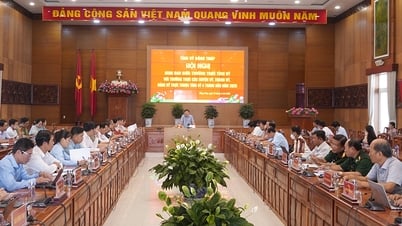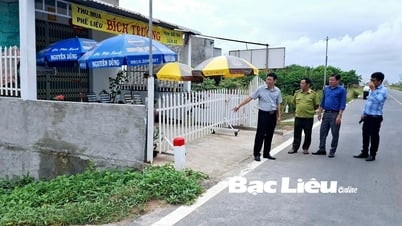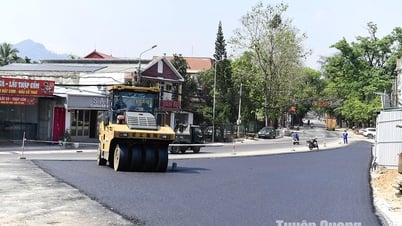
Nearly 20 years ago, implementing the Prime Minister 's direction in Official Dispatch No. 7189/DPI dated December 14, 1995, the Committee for Ethnic Minorities and Mountainous Areas (now the Committee for Ethnic Minorities) issued Circular No. 41/UB-TT dated January 8, 1996, stipulating criteria and guidelines for the delimitation of each region according to the level of development in ethnic minority and mountainous areas. This was the first time our country had delimited ethnic minority and mountainous areas according to the level of development. Since then, the investment policy system for ethnic minority and mountainous areas has been built on the spirit of investment in the most difficult areas, according to the criteria for delimiting 3 regions.
In addition to the delimitation according to the level of development, ethnic minority and mountainous areas are also delimited according to the set of criteria for mountainous and highland areas. This set of criteria was first established in 1992, as a basis for implementing Resolution No. 22/NQ-TW dated November 27, 1989 on a number of major policies and guidelines for socio-economic development in mountainous areas of the Politburo ; Decision No. 72/HDBT dated March 13, 1990 of the Council of Ministers (from April 1992 to present, the Government) on a number of specific policies and guidelines for socio-economic development in mountainous areas.
Along with the delimitation of mountainous and highland areas and the delimitation according to the level of development, in the process of implementing socio-economic development tasks, the Government has issued a number of additional forms of classification, such as: Delimitation of border areas on land and at sea; classification of coastal and island communes; classification of commune-level administrative units in difficult areas; classification of commune, ward and town-level administrative units. Each delimitation and classification has different criteria, purposes, scopes and objects for promulgating policies in different fields of State management.
Based on this set of criteria, on December 22, 1992, the Prime Minister authorized the Minister and Chairman of the Ethnic Committee to announce the list of communes, districts and provinces as mountainous and highland areas. Since then, the Minister and Chairman of the Ethnic Committee have issued 9 decisions recognizing communes, districts and provinces as mountainous and highland areas. These include: Decision No. 33/UB-QD dated June 4, 1993; Decision No. 42/UB-QD dated May 23, 1997; Decision No. 363/2005/QD-UBDT dated August 15, 2005;…
But, as mentioned above, from 1996 to present, investment policies and support for socio-economic development in ethnic minority and mountainous areas have been built and implemented on the basis of delimitation according to development level. So, why is it still necessary to delimit mountainous and highland areas?
Since 2017, the National Assembly's Ethnic Council has conducted a thematic supervision on "The implementation of the delimitation of ethnic minority and mountainous areas according to development level; the delimitation of communes, districts, and provinces as mountainous and highland areas". The supervision report shows that the goal of the delimitation of mountainous and highland areas is completely different from the delimitation according to development level.
Specifically, the demarcation of mountainous and highland areas is the basis for promulgating policies stipulated in the State Budget Law, Investment Law, Law on Organization of Local Government, etc. Demarcation according to development level is the basis for implementing investment policies and supporting socio-economic development of ethnic minority and mountainous areas.

At the 2nd Session of the Standing Committee of the 15th National Assembly (August 17, 2021) to consider the delimitation of mountainous and highland areas, Chairman of the National Assembly's Ethnic Council Y Thanh Ha Nie K'dam continued to affirm that the delimitation of mountainous and highland areas is necessary; has been and is an important basis for serving the task of State management and building mechanisms, laws, policies, and organizing the implementation of policies in communes, districts, and provinces that are mountainous and highland areas.
However, according to the assessment of the Chairman of the National Assembly's Council for Ethnic Minorities, the current main criteria for delimiting mountainous and highland areas are too simple (based only on the height above sea level and the number of administrative units), not reflecting the true nature and correlation between localities and regions. Therefore, it is urgent to revise the criteria for delimiting mountainous and highland areas to be scientific, practical and especially not overlapping with the criteria for delimiting according to the level of development.
Carrying out the tasks assigned by the National Assembly Standing Committee and the Government, the Ethnic Committee is presiding over the summary of the delimitation of mountainous and highland areas; at the same time, re-evaluating the criteria for delimiting the three regions to determine the construction and propose a new criterion that is more suitable, ensuring factors in terms of terrain, administrative boundaries, and development level for more focused, key and appropriate investment in the coming period.
Deputy Minister, Vice Chairman Y Vinh Tor works with the National Assembly's Ethnic Council on the Report on delimitation of mountainous and highland areas



![[Photo] General Secretary To Lam chairs a working session with the Central Internal Affairs Commission](https://vphoto.vietnam.vn/thumb/1200x675/vietnam/resource/IMAGE/2025/5/22/3b7790f499da45b2803d8ae253207ef1)
![[Photo] Press delegation meeting to visit Truong Sa and DK1 Platform](https://vphoto.vietnam.vn/thumb/1200x675/vietnam/resource/IMAGE/2025/5/22/6b8d232877ec421a9e8187d83b9f8006)

![[Photo] Prime Minister Pham Minh Chinh chairs meeting on draft Resolution of National Assembly on International Financial Center in Vietnam](https://vphoto.vietnam.vn/thumb/1200x675/vietnam/resource/IMAGE/2025/5/22/d398664ff1a140629169ea5a24e1b4d0)
![[Photo] T&T 1 and Ho Chi Minh City 1 People's Police Teams won the men's and women's team championships](https://vphoto.vietnam.vn/thumb/1200x675/vietnam/resource/IMAGE/2025/5/22/39db06ae67cb4001b7a556e8d9a56d07)























































![[Infographic] Investment project to build Tu Lien bridge and roads at both ends of the bridge](https://vphoto.vietnam.vn/thumb/402x226/vietnam/resource/IMAGE/2025/5/23/3c167ece69cb4aecb3e55de5ebc38b88)


























![[Podcast] Week introducing more than 500 OCOP products in Hanoi](https://vphoto.vietnam.vn/thumb/402x226/vietnam/resource/IMAGE/2025/5/22/d144aac2416744718388dbae3260e7fd)





Comment (0)